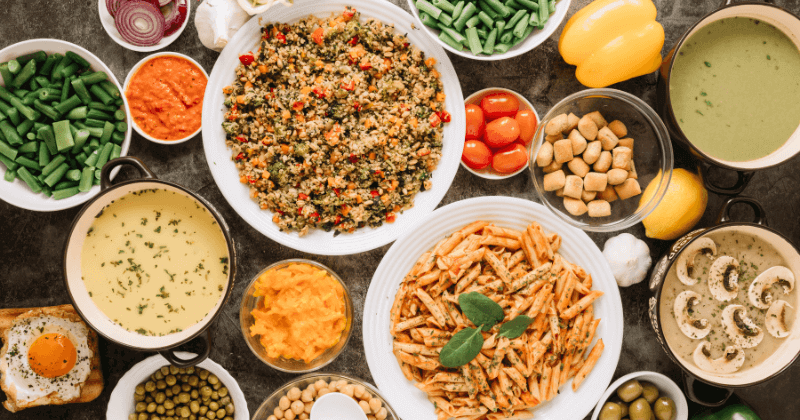10 High Protein Indian Food Chart
High Protein Indian Food - Protein is the building block of life. It’s essential for muscle repair, energy, and overall health.
In a country like India, where food is not just sustenance but a way of life, incorporating high-protein foods into your diet can be both delicious and culturally satisfying.
Whether you’re a fitness enthusiast, a vegetarian, or simply someone looking to improve their diet, this blog will guide you through a 10 High Protein Indian Food Chart that’s both nutritious and deeply rooted in Indian culinary traditions.
Let’s dive into the world of protein-rich Indian foods that are not only healthy but also incredibly flavorful.
Why Protein is Crucial for Indians?
Before we jump into the food chart, let’s understand why protein is so important, especially for Indians.
-
Vegetarian Dominance: A significant portion of the Indian population is vegetarian, relying heavily on grains and vegetables.
-
Active Lifestyles: From farmers to office workers, Indians lead active lives that demand energy and muscle repair. Protein helps in recovery and sustained energy.
-
Health Concerns: Protein deficiency can lead to muscle loss, weakened immunity, and fatigue. With rising health awareness, Indians are now prioritizing protein-rich diets.
By incorporating high-protein Indian foods, you can meet your daily protein requirements without compromising on taste or tradition.
The Ultimate 10 High Protein Indian Food Chart
Here’s a curated list of 10 protein-rich Indian foods that are easily available, affordable, and delicious.
10 High Protein Indian Foods are Paneer, Chana, Dal, Soybean, Quinoa, Eggs, Greek Yogurt, Peanuts, Milk, and Fish. Boost health with desi delights.
| Food Item | Protein Content | Why It’s Great |
|---|---|---|
| Paneer (Cottage Cheese) | 18g per 100g | A vegetarian powerhouse, versatile in dishes like palak paneer, paneer tikka, or sautéed with spices. |
| Chickpeas (Chana) | 19g per 100g | A staple in Indian cuisine enjoyed as chana masala, hummus, or boiled with spices for a quick snack. |
| Lentils (Dal) | 9g per 100g (cooked) | A daily staple in Indian households, packed with protein and fiber. Varieties include moong and masoor dal. |
| Soybean | 36g per 100g | A complete protein source, ideal for vegetarians. Try it as soy chunks curry or stir-fried with veggies. |
| Quinoa | 14g per 100g | Gaining popularity in India, use it as a rice substitute or in salads for a protein boost. |
| Eggs | 13g per 100g | A complete protein source. Enjoy boiled, scrambled, or as an omelet with Indian spices. |
| Greek Yogurt (Dahi) | 10g per 100g | Thicker and higher in protein than regular yogurt. Pair it with roti or use it in raita. |
| Peanuts (Mungfali) | 25g per 100g | A tasty and affordable snack. Enjoy roasted, as peanut chutney, or in chaat. |
| Milk | 8g per cup | A versatile protein source. Drink it plain, use in smoothies, or make traditional Indian sweets like kheer. |
| Fish (Rohu, Salmon) | 20-25g per 100g | A lean protein source. Coastal regions enjoy fish curry, fried fish, or tandoori fish. |
How to Incorporate These Foods into Your Daily Diet?
Now that you know the top 10 high-protein Indian foods, let’s talk about how to include them in your daily meals.
🌟 Breakfast Ideas
Poha with Peanuts: A light yet protein-packed breakfast.
Egg Bhurji: Scrambled eggs with Indian spices.
Greek Yogurt Smoothie: Blend yogurt with fruits and nuts.
🌟 Lunch Ideas
Dal-Roti-Sabzi: A classic Indian meal with lentils, whole wheat roti, and vegetables.
Chana Masala with Quinoa: A modern twist on a traditional dish.
🌟 Dinner Ideas
Paneer Tikka with Salad: Grilled paneer cubes with a side of fresh veggies.
Fish Curry with Rice: A coastal delight rich in protein and flavor.
🌟 Snack Ideas
Roasted Chickpeas: A crunchy, protein-rich snack.
Peanut Chutney with Veggies: A healthy dip for carrots or cucumbers.
Protein Requirements for Different Age Groups
The amount of protein you need depends on your age, gender, and activity level. Here’s a quick guide:
-
Children (4-13 years): 19-34g per day
-
Teens (14-18 years): 46-52g per day
-
Adults (19-50 years): 56g for men, 46g for women
-
Seniors (51+ years): 56g for men, 46g for women
Pregnant and breastfeeding women may need additional protein. Always consult a nutritionist for personalized advice.
Myths About Protein in Indian Diets
There are several misconceptions about protein in Indian diets. Let’s debunk a few:
✔ Myth 1: Only Non-Vegetarians Get Enough Protein
Fact: Vegetarian sources like lentils, paneer, and soybeans are excellent protein sources.
✔ Myth 2: Protein Supplements Are Necessary
Fact: A balanced diet can provide all the protein you need. Supplements are only necessary in specific cases.
✔ Myth 3: Eating Protein Makes You Bulky
Fact: Protein supports muscle repair and growth, but bulking up requires targeted exercise and calorie surplus.
Tips for Maximizing Protein Absorption
To get the most out of your protein-rich diet, follow these tips:
-
Combine Foods: Pair lentils with rice or roti to create a complete protein.
-
Eat Regularly: Spread your protein intake across meals.
-
Stay Hydrated: Water helps in digesting and absorbing protein.
-
Cook Smart: Avoid overcooking, as it can reduce protein content.
Conclusion
Protein is not just a nutrient; it’s a lifestyle choice that can transform your health. With this 10 High Protein Indian Food Chart, you can enjoy the best of Indian cuisine while meeting your protein needs.
From paneer to peanuts, these foods are not only nutritious but also deeply ingrained in our culture.
So, the next time you’re planning your meals, remember this chart. Whether you’re cooking at home or dining out, make protein a priority. Your body will thank you!
